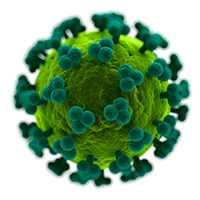A research team led by Weill Cornell Medical College scientists has discovered a way to limit replication of the most common form of HIV at a key moment when the infection is just starting to develop. The study, published June 25 in Nature Communications, has shed light on a potential new element of human immunity against HIV-1 and could provide a powerful new strategy — perhaps as part of an HIV vaccine — to limit the severity of the disease, which affects 35 million people worldwide and for which there is no cure.
Transmitted through bodily fluids, the HIV-1 virus thrives by infecting and destroying key immune cells, known as CD4 T cells, that would ordinarily mount an effective defense against the virus and initiate the antiviral activity of other immune cells. Scientists have long known that a substance produced by CD4 T cells called Interleukin-21 (IL-21) plays an important role in the immune system by activating immune cells that specialize in killing viruses like HIV-1 and driving the production of antibodies that attack them. But it was unclear how IL-21 might affect the early stages of HIV-1 infection that allows the virus to grow and spread unabated soon after a person is exposed.
Researchers from Weill Cornell, the Ragon Institute of Massachusetts General Hospital, Massachusetts Institute of Technology and Harvard University conducted two studies to uncover this effect. The researchers created a culture from human tissues, primarily spleen and lymph node tissue. After exposing the cells to IL-21, they introduced HIV-1 and found that after 72 hours, cultures with IL-21 contained more than two-thirds less virus than those that didn't receive the treatment.
The second model tested IL-21 in mice transplanted with human stem cells to create a physiological environment as close as possible to that in people. Over the course of two weeks, the mice began producing IL-21, and the effect held steady: After 14 days, more than half of the mice with IL-21 did not display a detectable level of HIV-1, with IL-21 reducing both the incidence and magnitude of disease.
An analysis of the results suggested that IL-21 not only jumpstarts the immune system but also thwarts the HIV-1 virus from replicating during a critical, early window of its development, when it is concentrated in one location and hasn't yet started to spread throughout the body.
"This study highlights components of the human immune system that are capable of mounting an antiviral response and driving intrinsic resistance to HIV-1," said senior author Dr. Laurie H. Glimcher, the Stephen and Suzanne Weiss Dean of Weill Cornell Medical College. "We are hopeful that this knowledge will help bring us one step closer to shielding patients from this deadly and complex virus."
The reduction in viral load is due to the cascade of events initiated by IL-21, one of the proteins that CD4 T cells produce to help carry out their immune function. The investigators found that IL-21 instructs CD4 T cells to increase the amount of a small RNA molecule. That molecule, microRNA-29 (miR-29), inhibits the replication of HIV-1, limiting the amount of virus produced from infected cells.
